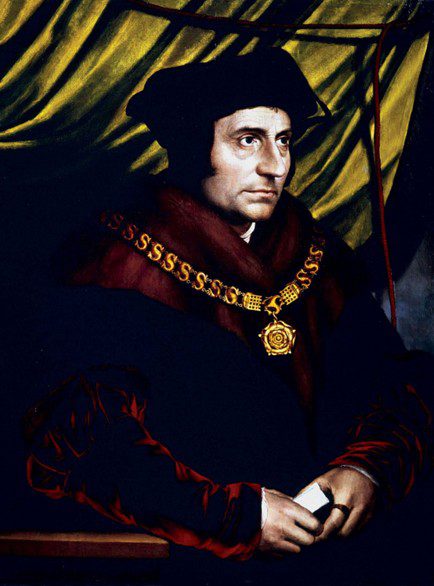Utopia and Intellectual Achievements
In 1516, Thomas published Utopia, a visionary work of fiction about a pagan, communist island governed by reason. The book explored themes such as justice, state-controlled education, religious tolerance, women’s rights, and euthanasia. It established him as a leading humanist and helped create the literary genre of the utopian romance.
Service to Henry VIII
In 1517, Thomas entered the service of Henry VIII, becoming one of his most trusted advisors. He acted as the King’s secretary, interpreter, speech-writer, diplomat, and confidant. Henry showered him with honours: he was knighted in 1521, elected Speaker of the House of Commons in 1523, and made Lord Chancellor of England in 1529.
However, his fortunes changed in 1527 when Henry sought an annulment of his marriage to Catherine of Aragon, hoping to marry Anne Boleyn. When Pope Clement VII refused to grant the annulment, Henry broke with Rome, declaring himself Supreme Head of the Church of England. Thomas, a man of profound integrity, could not support the King’s actions.
In 1532, he resigned as Chancellor and distanced himself from court affairs. His refusal to attend Anne Boleyn’s coronation further alienated him. Matters came to a head in 1534 when the Act of Succession required all subjects to swear an oath recognising Henry and Anne’s children as legitimate heirs and rejecting the authority of the Pope. Thomas refused, seeing this as a betrayal of his faith.
Imprisonment and Execution
On 17th April 1534, Thomas was imprisoned in the Tower of London. Despite a year of pressure to submit, he remained steadfast. In July 1535, he was convicted of treason in a sham trial and sentenced to death. On 6th July, he was beheaded, declaring before his execution: “I die the King’s good servant, but God’s first.”
Legacy
Thomas More was beatified in 1886 and canonised as a saint in 1935. He has since been adopted as the patron saint of many schools and organisations, embodying values of intellect, integrity, and service. He is an ideal role model for four key reasons:
- Scholarship – His love of learning led him to write Utopia, a vision of an ideal society.
- Advocacy for Education – As a father, he championed education, especially for women, which was rare for his time.
- Moral Courage – He refused to compromise his principles, even in the face of death.
- Public Service – He dedicated his life to others, serving as an educator, lawyer, religious thinker, and statesman.
At our school, we are called to serve others through fulfilling our mission to BeMore and ASPIRE, and Thomas More provides a powerful example to follow.





